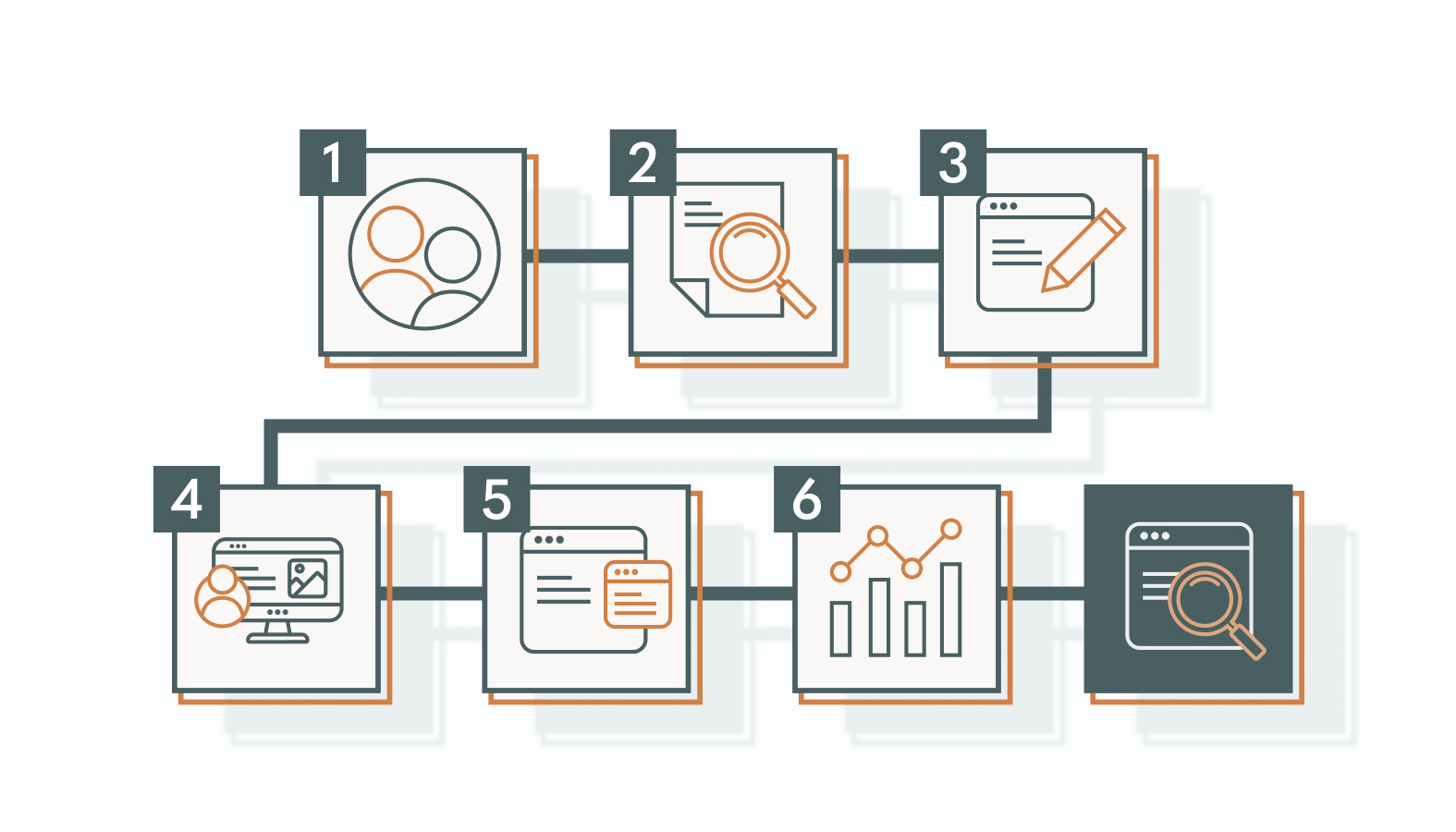You want your business to be found, not lost in the digital wilderness. And in 2025, ‘hoping’ for visibility isn’t a strategy; it’s a gamble with your bottom line. We’re talking about a calculated, surgical approach to content that doesn’t just tick boxes for search engines but connects with the people you need to reach.
We’ve all seen the digital landscape morph and intensify. Stagnant traffic, keyword strategies that belong in a digital museum, and tactics that simply don’t move the needle? That’s not just frustrating; it’s a symptom of missing the mark.
The cure? Content that’s both smart and human. Content that ranks, yes, but also resonates.
An SEO content strategy isn’t about pulling rabbits out of hats or chasing the latest shiny object. It’s about distilling decades of experience into a clear, actionable roadmap.
This guide strips away the guesswork and delivers essentials: the strategies that have proven themselves time and again.
Mastering SEO Content: The Art and Science of Visibility
In the competitive digital landscape, SEO content is your engine for dominance. It’s the difference between thriving and fading.
High-ranking pages aren’t accidental; they are meticulously crafted, fine-tuned for search algorithms, and designed to deliver sustained audience engagement.
What is Effective SEO Content?
SEO content isn’t just words; it’s strategic visibility. It bridges the gap between search algorithms and human understanding, attracting and converting.
Unlike random blogs, true SEO content is a precision tool built on targeted keywords, clear structure, and readability, answering user questions directly. It’s the difference between being found and forgotten.
How SEO Content Works & Its Impact
Effective SEO content is a finely tuned engine, balancing technical precision with compelling storytelling. It prioritizes user intent and builds credibility, all while demanding ongoing analysis and refinement for sustained success.
This calculated approach, a mix of value, relevance, and deep user understanding, signals to search engines that your site is an authoritative resource. Hit those points, answer the questions your audience is asking, and you’ll build engagement and trust.
But here’s the key: clicks are just the starting line. The real win is conversion. Great content anticipates user needs, delivers clear solutions, and guides them from initial curiosity to action.
Craft an SEO Content Strategy
To win in search, you need a smart content strategy. It’s about knowing what people search for, giving them what they want, and making sure search engines can find it.
Key Elements of a Winning SEO Content Strategy
SEO is a high-stakes game, and the rules are constantly changing. A strategic approach ensures your content ranks, engages and converts.
Keyword Research: The Foundation of Visibility
Keywords serve as the bridge between what people search for and what you offer. The right ones put you in front of the right audience. Use tools like Google Keyword Planner, SEMrush, or Ahrefs to uncover high-value search terms. But it is not just about picking the most popular words.
A winning keyword strategy balances three key factors:
- Search Volume: How often people search for a term.
- Competition: How difficult it is to rank for that term.
- Relevance: Whether the keyword aligns with your content and business goals.
Long-tail keywords often bring in highly targeted traffic with less competition. Instead of chasing broad, high-competition terms like “fitness training,” a more strategic approach would target “best strength training for beginners” or “how to build muscle with bodyweight exercises.”
Content Optimization: Make Every Word Count
Getting visitors to your site is one thing. Keeping them there and turning them into customers is another. To maintain visitor engagement and drive conversions, content must be informative, engaging, and structured for readability.
Here is how to make your content work harder for you:
- Provide Real Value: Answer user questions with expert-level insights, not generic fluff.
- Use Keywords Smartly: Integrate them naturally in headings, body text, and meta descriptions without overstuffing.
- Format for Engagement: Break up long blocks of text with subheadings, bullet points, and visuals to keep readers scrolling.
Tracking performance with Google Analytics and Google Search Console helps fine-tune your strategy by revealing which pages drive traffic, where users drop off, and what content converts best.
User Intent: Align with What People Want
Search engines have gotten smarter. Ranking is no longer just about keywords. Google prioritizes content that aligns with search intent, meaning your content must match what users are actually looking for.
Search queries typically fall into three categories:
- Informational: “What are the benefits of organic skincare?” These users want knowledge, not a sales pitch. Answer their questions thoroughly.
- Navigational: “XYZ Skincare product reviews.” They already know where they want to go. Make sure your website is easy to find and navigate.
- Transactional: “Best organic face moisturizer for dry skin.” These users are ready to take action. Your content should make it easy for them to make a purchase.
Understanding intent allows you to craft content that meets users where they are in their journey. The closer the match, the higher the engagement.
Beyond Content: How Technical, On-Page, and Off-Page SEO Drive Success
Content may be the heart of SEO, but without the right foundation, optimization, and authority-building, even the best content can get lost in the noise.
A well-rounded strategy stands on four pillars:
- Technical SEO
- On-page SEO
- Off-page SEO
- Content
Each pillar plays a distinct role in boosting visibility, engagement, and long-term success.
Technical SEO is the engine that keeps your site running smoothly.
If search engines can’t properly crawl, index, or interpret your content, rankings will suffer. Yes, even if you produced terrific content.
Optimizing site speed, mobile responsiveness, structured data, and security (HTTPS) ensures both users and search engines have a frictionless experience.
Tools like Google Search Console help monitor indexing issues, so nothing stands in the way of discoverability.
On-page SEO is where optimization meets user experience.
Every page must communicate its relevance clearly and efficiently, both for search engines and real people.
Title tags, meta descriptions, header structures, and strategic internal linking make it easier for Google to understand your content while keeping users engaged.
Proper keyword placement, well-organized headings, and a scannable format make it easier for humans to digest information. As a result, it improves readability, reduces bounce rates, and increases conversions.
Platforms like WordPress and HubSpot simplify on-page optimization, ensuring every page is primed for performance.
Off-page SEO is the authority builder.
Search engines look at your site’s reputation across the web. Backlinks from trusted, high-authority sources signal that your content is valuable and credible.
Link-building strategies like guest blogging, digital PR, and strategic partnerships boost domain authority and help your content rank higher.
Social signals and brand mentions also contribute to visibility. It reinforces your site’s expertise in its niche.
Tools like SEMrush’s backlink analysis help track and refine off-page efforts.
For your SEO content strategy to perform well, technical, on-page, and off-page SEO must work together and make your site more discoverable, authoritative, and positioned for long-term success.
Your Roadmap to an Effective SEO Content Strategy
To attract the right audience to your site, you need an SEO content plan that’s laser-focused: understanding precisely who they are, what they’re searching for, and delivering content that speaks directly to them — all while ensuring search engines can effectively connect the dots.
Here’s how to do it:
1) Identify Your Audience and Their Needs
If you’re crafting SEO content without a crystal-clear picture of who you’re speaking to, you’re shooting in the dark.
To create content that ranks and converts, you need to pinpoint exactly who your audience is, what they care about, and how they search for information.
Start by segmenting your audience both demographically (age, location, income, job title) and psychographically (pain points, motivations, lifestyle, decision-making triggers).
These insights shape how you approach everything, from keyword research to the tone and structure of your content.
How to Properly Identify Your Audience
- Analyze Existing Data: Start with what you already have. Website analytics (Google Analytics, GA4), CRM data, and past customer interactions reveal who’s engaging with your brand and what content they find valuable.
- Conduct Audience Research: Use customer surveys, feedback forms, and direct conversations to uncover their biggest challenges and interests. If you don’t ask, you’ll never know.
- Monitor Search Behavior: Keyword research tools like Google Keyword Planner, SEMrush, and Ahrefs help decode the exact words and phrases your audience uses. Speak their language, not industry jargon.
- Leverage Social Listening: Platforms like Brandwatch, Hootsuite Insights, and Sprout Social track real-time conversations, giving you unfiltered insights into what your audience cares about.
- Check Out the Competition: Tools like BuzzSumo and Ubersuggest reveal what’s working for competitors in your space. If certain topics are driving engagement for them, they likely resonate with your audience too.
By layering these insights, you create a data-driven audience profile that guides every content decision. The better you understand your audience, the more precise and impactful your SEO strategy becomes.
2) Conduct In-Depth Keyword Research
When you prioritize strategic keyword research, your content becomes a magnet for your ideal audience, increasing engagement and driving long-term SEO success.
Benefits of Optimized Content
- Boosts Visibility: Search engines need context to understand and rank your content. Keywords act as SEO signals, helping Google and other search engines categorize your page and match it with relevant searches.
A local HVAC company optimizing for “emergency AC repair in Dallas” instead of just “AC repair” stands a better chance of appearing in searches from homeowners needing urgent service.
- Attracts Qualified Traffic: The right keywords ensure your content reaches people actively searching for what you offer, not just random visitors. High-intent keywords drive visitors who are more likely to convert.
An e-commerce store selling organic skincare products ranks for “best organic moisturizer for sensitive skin” instead of the broad, highly competitive “moisturizer.” This brings in buyers looking for exactly what they sell.
- Increases Engagement & Conversions: Content aligned with search intent keeps visitors on your page longer, reducing bounce rates and improving user experience.
A SaaS company targeting “best CRM software for small businesses” will engage readers far more effectively than if they only optimized for “CRM software,” which attracts broader, less targeted searches.
- Supports Long-Term SEO Growth: A solid keyword strategy helps build topic authority, making it easier for your content to rank over time. Search engines recognize your site as a go-to source in your niche, improving rankings across multiple related keywords.
A fitness blog consistently publishing articles around “strength training for beginners,” “best dumbbell workouts,” and “how to build muscle at home” establishes credibility, leading to better rankings for all strength-training topics.
SEO isn’t about guessing. The right keywords put you in front of the right people at the right time with the right message.
3) Create Compelling and Valuable Content
Yes, SEO is mostly about ranking, but what makes people stay is content that resonates. You can have the best keywords in the world, but if your content doesn’t engage, inform, or provide value, it won’t convert.
Search engines prioritize high-quality, user-focused content because that keeps people coming back. Here are reasons to focus on this:
- Builds Authority & Trust: Google’s E-E-A-T (Experience, Expertise, Authoritativeness, Trustworthiness) framework rewards content that demonstrates expertise and credibility. Thoughtful, well-researched insights position your brand as a go-to resource in your industry.
A cybersecurity company publishing an in-depth guide on “How to Protect Your Business from Phishing Attacks” earns trust from business owners seeking actionable advice, increasing the likelihood of conversions.
- Drives Engagement & Retention: If your content answers real questions, solves pain points, or teaches something new, people stay longer, interact more, and return for future content.
A travel blog featuring an interactive “Ultimate Packing Checklist for Europe” keeps users on the page as they check off items, signaling high engagement to search engines.
- Encourages Shares & Backlinks: Exceptional content earns organic backlinks from reputable sources, which are SEO gold. The more high-quality sites link to your content, the more search engines view your site as a trusted authority.
A marketing agency publishing an original case study on “How AI Transformed Lead Generation” might be referenced by industry blogs, universities, and professionals. All the mentions could help expand the agency’s reach and authority.
- Evergreen Content Powers Long-Term Growth: High-quality content compounds over time, continuously bringing in traffic and leads long after publication. Unlike short-lived trends, well-crafted, evergreen content builds authority and keeps working for you.
A “Definitive Guide to SEO for E-commerce” remains relevant for years, consistently attracting new audiences and maintaining rankings.
- Keeps Your Brand Top of Mind: Generic, surface-level content gets ignored. Unique, insightful content makes your brand memorable, bringing people back even when they’re not actively searching.
A fitness coach regularly sharing myth-busting articles like “Why Cardio Isn’t the Best for Fat Loss” keeps their audience engaged, building long-term brand loyalty.
The harsh truth is that low-effort content gets buried. If you’re not offering unique insights, expert analysis, or real solutions, you’re just adding to the noise.
The brands that win in SEO don’t chase algorithms exclusively. They prioritize quality every time and create content that deserves to be top of search results.
4) Optimize Content with On-Page SEO Techniques
You can write the best content on the internet, but if it isn’t optimized for search engines and user experience, it won’t reach the audience it deserves.
On-page SEO is the difference between content that ranks and content that gets buried. It ensures every page on your site is structured, formatted, and fine-tuned to attract both search engines and real people.
Why On-Page SEO Is Non-Negotiable
- Search Engines Need Clarity to Rank Your Content: Google’s algorithm is sophisticated, but it still needs clear signals about your content’s topic, relevance, and value. Strong title tags, meta descriptions, and header structures make it easier for search engines to understand and rank your page.
A blog titled “10 Essential Pool Maintenance Tips” with a compelling meta description like “Discover expert-backed pool care strategies to keep your water crystal clear year-round” will attract more clicks and better rankings than a generic, keyword-stuffed title.
- User Experience Impacts Rankings: On-page SEO is about making content readable, accessible, and engaging. Google prioritizes fast, mobile-friendly pages that offer seamless navigation.
If a page loads slowly or isn’t mobile-responsive, visitors will bounce, which signals to Google that the content isn’t valuable. Optimizing image sizes, improving site speed, and using mobile-friendly design keep users engaged and rankings intact.
- Structured Content Boosts Engagement & Readability: SEO-friendly formatting isn’t just for search engines; it must keep readers on the page longer.
Well-structured headings, bullet points, and internal links help users skim efficiently and find what they need. Clear H2s for each step and internal links to related topics will keep readers engaged and encourage further exploration.
- Optimized Pages Convert Better: SEO aims to turn visitors into leads and customers. The proper on-page optimizations, such as compelling CTAs, strategically placed keywords, and intuitive site structure, guide users toward taking action.
A pool service page that includes localized keywords (“Plumbing service in Austin, TX”), trust signals (testimonials, guarantees), and clear CTA buttons (“Get a Free Quote”) will outperform a page without those optimizations.
On-page SEO is more than checking a few boxes: it’s about making sure your content is search-friendly, user-focused, and built for conversions. Without it, even the best content will struggle to rank, engage, and convert.
If you want to win in SEO, write content, then optimize it to perform.
5) Promote Content and Build Backlinks with Off-Page SEO
Creating stellar content is only half the battle. The other half? Getting it seen, shared, and endorsed.
That’s where off-page SEO comes in. While on-page SEO optimizes what’s on your site, off-page SEO strengthens its credibility across the web.
Think of it as your site’s reputation builder. The more high-quality endorsements (backlinks) and brand mentions you earn, the more trust and authority you establish with search engines.
Why Off-Page SEO Matters
- Backlinks Are Google’s Trust Signals: Not all links are created equal. High-authority backlinks from trusted sites tell search engines your content is valuable and credible — helping you rank higher.
For example, a link from Forbes or HubSpot carries more weight than one from an unknown blog. A well-placed guest post on an industry-leading site can skyrocket your SEO and referral traffic.
- Brand Mentions Increase Search Authority: Even without a direct link, mentions of your brand across the web reinforce your credibility.
If a well-known tech publication references your AI research in an article, Google associates your brand with authority in the AI space.
- Social Signals Indirectly Boost Rankings: Social media doesn’t directly impact SEO but fuels the fire, drives engagement, and expands your reach.
A viral LinkedIn post about “The Future of Remote Work” can drive massive engagement, leading to more website visits, backlinks, and higher search rankings.
- Local SEO Relies on External Credibility: For businesses targeting a local audience, off-page SEO is critical. Local citations, directory listings, and positive Google reviews all contribute to local search visibility.
A boutique marketing agency with consistent NAP (Name, Address, Phone) listings across platforms like Google My Business, Yelp, and industry directories will outrank competitors with incomplete or inconsistent listings.
To dominate off-page SEO, build high-quality backlinks through strategic partnerships and guest posting, actively promote your content across relevant platforms, engage authentically within online communities, and diligently encourage positive reviews.
When executed with precision, these tactics elevate your content’s visibility and solidify your brand as a trusted authority.
6) Monitor Results and Refine Your Strategy
SEO is a dynamic process that demands constant attention. You’ve built the strategy. Now, you need to know if it’s hitting the mark. This is where data becomes your most valuable asset.
Dive into Google Analytics to understand traffic patterns, user behavior, and conversion rates. Cross-reference that with Google Search Console to track keyword performance, indexing issues, and overall site health.
By deep-diving into analytics, you can translate those numbers into actionable insights.
The key is iterative improvement.
- Don’t be afraid to tweak your keyword strategy
- Refresh outdated content
- Overhaul your link-building tactics based on what the data tells you.
Market conditions shift, search algorithms evolve, and your business goals adapt. Your SEO strategy must do the same. This proactive, data-driven approach is the only way to ensure your efforts remain effective, competitive, and consistently aligned with your objectives.
Avoiding Common SEO Mistakes
Simple missteps can hurt your SEO success. Spotting and fixing these errors keeps your strategy strong. Here are the common SEO mistakes and how to stay on track.
Neglecting Keyword Research
Skipping keyword research means guessing what your audience searches for. That’s how content gets buried instead of ranking.
Without the right keywords:
- Your content lands in front of the wrong audience — or no one at all.
- Search engines can’t properly index or rank your pages.
- You waste time creating content that doesn’t drive real results.
Smart SEO starts with strategic keyword targeting. Otherwise, you’re just throwing darts in the dark.
Ignoring Search Intent
When content doesn’t match what users are actually looking for, engagement tanks. Visitors bounce, search engines take note, and rankings drop.
If your page doesn’t deliver relevant answers quickly, users will find them elsewhere. That means lost traffic, missed conversions, and wasted effort.
Search engines reward content that satisfies intent. If your page isn’t aligned with user expectations, it will either perform poorly or not perform at all.
When weighing search intent, every piece of content must answer a question, solve a problem, or provide value. Otherwise, it’s just noise.
Overlooking Mobile Optimization
Neglect mobile optimization, and your SEO strategy will take a hit. A clunky, unresponsive site frustrates users, spikes bounce rates, and tanks dwell time. Search engines notice. If mobile visitors don’t stick around, Google assumes your content isn’t worth ranking.
And here’s the kicker — Google’s mobile-first indexing means your mobile site is your site in the eyes of the algorithm. A poor mobile experience doesn’t just limit visibility; it actively buries your content.
Want to stay competitive? Optimize for mobile first, not as an afterthought.
Poor Quality Content
Weak content is the kryptonite of a strong SEO strategy. If your content lacks originality, depth, or relevance, your audience will tune out fast. High bounce rates and short session durations tell search engines your site isn’t worth ranking.
Poor content also chips away at your credibility. Your site won’t attract organic traffic or build trust without value-packed, engaging material. Search engines reward authority; without it, your visibility takes a nosedive.
Strong SEO starts with high-quality content. Inform, engage, and give users a reason to stay. Anything less, and you’re just making it easier for the competition.
Not Preparing for Evolving Technologies & Trends
If you’re not anticipating the future, you’re already behind. SEO isn’t static; it’s a rapidly evolving landscape driven by technology. Ignoring emerging trends is a surefire way to watch your rankings plummet.
Consider these key advancements shaping search today:
- AI and Semantic Search: AI is reshaping search as we know it. With advancements in natural language processing, search engines are getting eerily good at understanding nuanced queries and user intent.
If your content isn’t optimized for semantic search (understanding the meaning behind words, not just the words themselves), you’re going to get left behind.
- Voice search: The rise of smart speakers and voice assistants means users are increasingly asking questions conversationally.
Are you optimizing for long-tail, conversational keywords? Are you providing concise, direct answers that voice search can easily digest? If not, you’re missing out on a massive opportunity.
- Visual search: Google Lens and similar technologies are changing how people discover products and information.
Are your images optimized with descriptive alt text and structured data? Are you creating visually engaging content that caters to this trend?
- Personalized Search Experiences: Search engines are getting better at tailoring results based on user location, search history, and preferences.
If your strategy doesn’t account for this level of personalization, you’re delivering a generic experience that won’t resonate.
Don’t be caught off guard. Stay ahead by continuously monitoring industry publications, attending conferences, and experimenting with new technologies.
Failing to adapt is a strategic blunder. Anticipate the future and position your brand for long-term success.
Mastering SEO in 2025 & Beyond: Strategy, Execution, and Impact
In a digital landscape that never stops evolving, an intentional SEO content strategy is the foundation of online success.
To maintain visibility and drive meaningful results, keep these core principles at the forefront:
- Know Your Audience: Use data-driven insights to craft content that resonates and delivers real value.
- Refine Your Keyword Strategy: Stay ahead of shifting search behaviors to keep your content relevant.
- Prioritize Quality: Create authoritative, engaging content that builds trust with both users and search engines.
- Optimize for Mobile & Technical SEO: Fast, seamless, mobile-friendly experiences aren’t optional—they’re expected.
- Promote & Analyze: Distribute strategically, measure performance, and refine continuously.
SEO isn’t about quick wins — it’s about sustainable growth. The brands that dominate search aren’t just reactive; they’re proactive. Stay agile, lead with data, and keep evolving. That’s how you win in 2025 and beyond.
Optimizing Your SEO for Long-Term Success
SEO is an evolving strategy that compounds over time. With the right approach, you’re not just improving rankings, you’re building lasting authority.
If you want to sharpen your strategy or need a seasoned partner to help execute, schedule a candid conversation with one of our experts. Let’s talk about your goals and how to get there faster.










